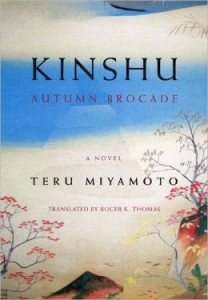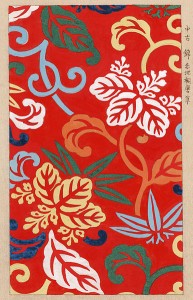“Though I was a married man, I had an affair with another woman that escalated to a scandalous event; there was no way I could justify what I had done. I don’t think there could have been a more compelling reason for a divorce. I upset too many people. I suffered an injury, but the wound inflicted on you was undoubtedly much greater.”—Arima Yasuaki, to his former wife.
 Winner of three major Japanese prizes during his long writing career, author Teru Miyamoto is still virtually unknown to English-speaking audiences. Sadly, Kinshu: Autumn Brocade, published in Japan in 1982 and translated into English by Roger K. Thomas in 2005, remains the only one of his novels available in English. In this quietly elegant novel focusing on the effects of a failed marriage on the two participants, Miyamoto explores the importance of marriage and its ramifications in Japanese society, emphasizing the characters and their culture rather than the kind of plot development and grand climax expected by most western readers. Readers interested in the effects of culture on character may find, as I did, that Miyamoto’s focus feels completely honest, true to life in ways that many plot-based novels do not, and this novel’s concise form allows him to explore serious themes without being held captive to plot.
Winner of three major Japanese prizes during his long writing career, author Teru Miyamoto is still virtually unknown to English-speaking audiences. Sadly, Kinshu: Autumn Brocade, published in Japan in 1982 and translated into English by Roger K. Thomas in 2005, remains the only one of his novels available in English. In this quietly elegant novel focusing on the effects of a failed marriage on the two participants, Miyamoto explores the importance of marriage and its ramifications in Japanese society, emphasizing the characters and their culture rather than the kind of plot development and grand climax expected by most western readers. Readers interested in the effects of culture on character may find, as I did, that Miyamoto’s focus feels completely honest, true to life in ways that many plot-based novels do not, and this novel’s concise form allows him to explore serious themes without being held captive to plot.
 When the novel opens, Aki, age 35, is taking a spur-of-the-moment trip up Mount Zao with her physically and mentally handicapped son so he can view the autumn stars. When they get settled into the gondola for the ride to the top, Aki is startled to discover that her ex-husband, Yasuaki, is sharing the car. They acknowledge each other briefly, and, after arriving at the end of the ride, go their separate ways without further communication, she accompanying her crippled son (by her second husband) as he slowly makes his way to the top of the mountain on crutches, and Yasuaki to an inn, where he observes their passage through the window.
When the novel opens, Aki, age 35, is taking a spur-of-the-moment trip up Mount Zao with her physically and mentally handicapped son so he can view the autumn stars. When they get settled into the gondola for the ride to the top, Aki is startled to discover that her ex-husband, Yasuaki, is sharing the car. They acknowledge each other briefly, and, after arriving at the end of the ride, go their separate ways without further communication, she accompanying her crippled son (by her second husband) as he slowly makes his way to the top of the mountain on crutches, and Yasuaki to an inn, where he observes their passage through the window.
The unexpected resurfacing of Yasuaki in Aki’s life leads her to write him a long letter a few months later, examining the dramatic events which led to their separation—the discovery of Yasuaki, unconscious, in a hotel room, beside a female companion, who is dead. The apparent double suicide attempt, which became a public scandal, led to Yasuaki’s insistence on a divorce, to which Aki, the aggrieved wife, agreed, reluctantly. Explaining to Yasuaki how she felt at that time, Aki finally sends the letter several months later, not expecting an answer. Two months later, however, he responds, telling her why he was in the hotel room with another woman and what he was thinking at the time he asked for a divorce.
 In the subsequent six letters which Aki writes over the course of ten months, most of which Yasuaki answers, the full impact of the divorce on both Aki and Yasuaki becomes clear. Each has made a new life, Aki as the wife of a college professor and mother of a handicapped son, and Yasuaki as a man who has failed in a series of business ventures. They also discover the depths of their misunderstandings, explore the new lives they have created since their divorce, and come to terms with their futures. It is in the details of their new lives that author Miyamoto explores the meaning of the self, the relationship between men and women in Japan (emphasizing the secret strength of women and weakness of men), the importance of family pride, and the meaning of karma, which controls outcomes of life and death.
In the subsequent six letters which Aki writes over the course of ten months, most of which Yasuaki answers, the full impact of the divorce on both Aki and Yasuaki becomes clear. Each has made a new life, Aki as the wife of a college professor and mother of a handicapped son, and Yasuaki as a man who has failed in a series of business ventures. They also discover the depths of their misunderstandings, explore the new lives they have created since their divorce, and come to terms with their futures. It is in the details of their new lives that author Miyamoto explores the meaning of the self, the relationship between men and women in Japan (emphasizing the secret strength of women and weakness of men), the importance of family pride, and the meaning of karma, which controls outcomes of life and death.
Though the novel is “quiet” and has little plot-based excitement, the many repeating motifs add impact and genuine feeling to the novel. Early on, Aki explains that after her divorce, she became a habitué of the Mozart coffee house/bookstore, a place that played the music of Mozart exclusively. Moved by a particular Mozart piece, she once thought she heard echoes of living and dying in it, declaring that “Perhaps living and dying are the same thing,” a statement she does not understand when she makes it. The repeating image of Mozart’s music with its emphasis on “living and dying,” and its connection with karma, a Buddhist concept, in the reconciliation of life and death, add depth and universality to the themes.
In addition, the word “kinshu” in the title combines the meanings of the Japanese words for “embroidery” and “brocade,” which, according to the translator, Roger K. Thomas, have been traditionally associated with autumn in Japanese literature. The brocade imagery repeats, as does the symbolism of autumn, the season in which Aki and Yasuaki meet on the mountain, a harbinger of winter and death.
Conveying an intimate picture of one traditional, semi-arranged marriage, Miyamoto provides a close look at the essence of marriage and its importance in Japanese culture. Because the book was written in 1982 for a Japanese audience, an outsider may not be privy to some of the subtleties – i.e., whether the author is offering a criticism or simply revealing a reality of the period – but Miyamoto’s depiction of the suffering of both Aki and Yasuaki, and their inability to share their feelings within the traditional cultural milieu in which they live, cannot help but affect the reader’s perceptions. Immense sympathy is evoked as these two people find their lives permanently affected because they have been unable to surmount the barriers placed by the traditions which they accept as part of their lives. As Aki and Yasuaki continue their new lives and try to understand the past, the reader also realizes that though the culture in which these new lives unfold differs from that of western readers, the human qualities of these individuals and their feelings are universal. Like other people who have few, if any, choices in life, these characters just carry on.
Photos, in order: The author’s photo is from http://aoiyane.seesaa.net
The gondola ride in the autumn appears on http://www.visitjapan-tohoku.org.
Mt. Zao in the fall, by Kumamushi, is from http://commons.wikimedia.org
The Nishike brocade appears on http://commons.wikimedia.org/


